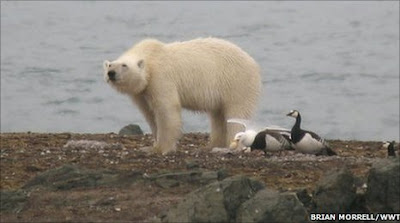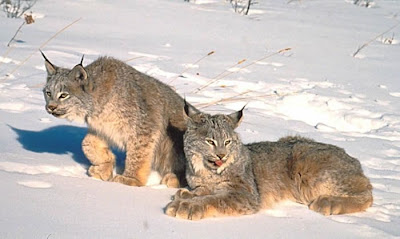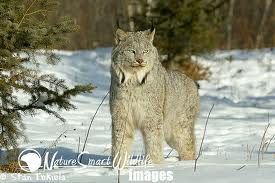Lynx don't care about the line between Ontario and Minnesota, and researchers on both sides are starting to pay attention.
By Cheryl Lyn Dybas with Photography by Ilya Raskin; canadiangeographic.ca
Ron Moen rattles his grey pickup truck down a back road covered by hard-packed snow in Minnesota's Superior National Forest, a few dozen kilometres south of the Canada–U.S. border. We're surrounded by a winter wonderland of rime-tipped balsam firs and frozen lakes that stretches north to Ontario and beyond. Moen skids to a halt beside a steep snowdrift, and we step out of the truck into banks so deep, they stop the six-foot-tall wildlife biologist in his tracks. It's early March, dusk is settling, and all is silent. Moen and I slog a few metres toward the forest edge and enter a thicket of firs and alders, their boughs doubled over with ice from a recent storm. His voice muffled by the collar of his parka, Moen whispers, "It's out there. Somewhere."
 |
| Map the Lynx's range around Lake Superior. |
"It" is
Lynx canadensis, a northern forest cat as elusive as sasquatch. Known to the Ojibwa as "the vigilant protector of the people," the lynx sees without being seen in this white-on-white world. Here in the boreal forest, the medium-sized wild cat, which can grow to a metre in length and averages 5 to 15 kilograms, appears to have it all: its main prey, the snowshoe hare; the brushy woods the hare prefers; and the deep snows that the lynx and hare bound across using the thick cushions of hair on the soles of their large feet. But the lynx — which lives in all provinces except Prince Edward Island and in Minnesota, Maine, Montana, Washington, Wyoming, Alaska and Colorado, where a reintroduction program has been under way since 1999 — became a prize catch when fur prices boomed in the 1970s and 1980s. It was hunted and pushed to the brink in the lower 48 states and has been listed as a threatened species for a decade, even though it is still trapped, mostly for fur coats, in Canada. (In response to overharvesting in the early 1900s, Ontario instituted a trapline registration system in 1947; the province's population is said to be recovering.)
"A scenario predicted by climate-change models says the cat's habitat could move as much as 200 kilometres by 2100."
Minnesota Lynx
|
Biologists at Environment Canada believe there are at least 110,000 lynx in the country. Because the lynx is so secretive, however, population estimates are just that — estimates. Nobody knows how many live in the United States. (There may be lynx in Oregon and Idaho and from Wisconsin to New Hampshire, but experts believe the animals occasionally pass through and do not constitute established populations.) Fewer than 250 likely live in Minnesota, says Moen, a reserved 49-year-old based at the University of Minnesota Duluth. And as the continuous snow cover and boreal forest shift north, a scenario predicted by climate-change models, the cat's habitat could move as much as 200 kilometres by 2100. Which means, says forest ecologist Lee Frelich of the University of Minnesota Twin Cities, "Canadian wildlife biologists need only look south" to see the conservation challenges they'll be facing in the near future.
Scientists on both sides of the border are trying to discover how much lynx populations in Ontario and Minnesota intermingle and which parts of the landscape play a critical role in their border crossings. Needless to say, lynx don't respect the international boundary, crossing the line regularly in search of meals or mates. Yet because they're a threatened species in the United States, they're managed completely differently in the two countries, says Justina Ray, a biologist at the Wildlife Conservation Society Canada.
Minnesota is currently at the southern edge of the lynx's range east of the Rockies. Superior National Forest and Bridger-Teton National Forest in Wyoming are two "priority areas" for lynx conservation, according to a 2007 report by The Nature Conservancy. "Intensive natural resources management intervention" will be required, the report says — in other words, the type of work that has taken Moen into these woods in search of lynx for more than seven years.
Out of sight behind the alders, Moen has set five box traps. Made of steel fencing and wood, with a trigger mechanism that shuts the door, the rectangular enclosures are baited with road-killed deer. Once trapped, as 35 have been over the years, the lynx is tranquilized using a pole syringe and is fitted with a Global Positioning System (GPS) or a Very High Frequency (VHF) radio collar so that Moen and his colleagues can track its movements. Moen also takes a blood sample to determine the animal's health and for DNA analysis to identify individuals.
There are no lynx in Moen's traps today, so we retreat to his truck. He opens the door and leans in, then emerges brandishing what looks like old-style TV rabbit ears to listen for the lynx already collared for his study. Each collar has its own frequency, which Moen can search for on his radio receiver. At first, we hear static. Then suddenly: beep-beep-beep.
"It's probably closer than we know," says Moen, peering into the darkness. Still, he decides to head back to town for the night. Lynx are most active at sunrise and sunset, so we'll return at dawn. The best way to catch a lynx, he says, is to think like one.
 |
| Map the range of the Lynx around Lake Superior. |
While we sleep at a ski-and-snowshoe lodge about 40 kilometres from Moen's traps — an outpost complete with snowshoes hanging cross-hatched above a stone fireplace — lynx number 28 in Moen's study roams the forest. By the waning light of a last-quarter moon, L-28 walks with its hindquarters up and head down — typical lynx posture — leaving paw prints as big as a man's hand in the deep snow. The lynx circles a small lake and crosses a frozen alder swamp; it can smell fresh deer meat. It pads along a snowmobile trail a meal, the door of trap number one slams shut.
Next morning, I'm on my way back to the woods with Moen, two of his students and a field assistant. We park in yesterday's tire marks and see lynx tracks leading into the trees, as well as signs of a snowshoe hare darting to and fro.
Moen follows his boot prints to the first trap and is met by a pair of soul-searching, translucent green eyes. Crouching in the back of the trap, distinctive black ear tufts standing up, L-28 makes a low noise that's half growl, half hiss. Clearly, the cat didn't appreciate its overnight accommodations. Because L-28 already has a radio collar — it was first trapped in 2005 — Moen sidles to the back of the trap and slides open the door. I stand a metre away in thigh-deep snow. L-28 bounds out and over the snow in a flash, his oversized paws in near-gallop, lynx and forest blurring together as one.
"Crouching in the back of the trap, distinctive black ear tufts standing up, L-28 makes a low noise that's half growl, half hiss."
Minnesota Lynx
|
One way to ensure that the lynx has a future in Minnesota, says Moen, is through "responsible" management programs in Canada and the United States that consider the animal's habitat along natural and not political lines. He has been quietly working to make that happen, organizing international workshops and collaborating with researchers, including OntarioMinistry of Natural Resources biologist Neil Dawson and Trent University ecologist Dennis Murray. They attended a 2007 gathering in Grand Portage, Minnesota, that drew together more than 70 wildlife biologists. It was the first workshop to assemble such a large number of lynx researchers from both sides of the border, fostering a small wave of international collaboration among scientists studying the animal. Which is important, because, as Moen says, "the frequency of cross-border lynx travel turns out to be much higher than anyone anticipated."
Some lynx in Moen's study, such as L-15, are veterans of back-and-forth forays. Trapped in Grand Marais, Minnesota, on March 30, 2004, L-15 was recorded northwest of Thunder Bay five months later — more than 150 kilometres away. Less than two weeks after that, L-15 was back in Grand Marais. It's usually males that wander far afield, says Moen. Females, probably because they have kittens, have smaller home ranges, which can vary from 60 to 100 square kilometres. This spring, however, a lynx in another study set a new record, travelling 2,000 kilometres from its transplanted home in Colorado back to Alberta before meeting its end in a fur trap.
Minnesota Lynx
Minnesota logger Joe Foster saw a lynx mother with her young in 2002. Two years later, Moen found lynx dens and saw a female lynx with kittens. These sightings constituted the first direct evidence that Minnesota has a resident lynx population.
There's another connection between logging and lynx: researchers have concluded that the success of a lynx population in its southern range depends not on old-growth forest, as had long been thought, but on early successional forest — woods with trees from 10 to 30 years old. Snowshoe hares, which make up more than 80 percent of the lynx's diet, hide there in young thickets or in "edgerows," the northern wilderness equivalent of the hedgerows where rabbits hop.
Moen's traps are located in a region of spruce-fir forests in early successional stages. Sections periodically harvested for timber are scattered across the area. Many have young trees springing up amid a lynx favourite: jumbles of downed branches atop scrubby undergrowth. "Logging isn't all bad for lynx," says Moen. "In some ways, it's the modern equivalent of [the regenerative] fires that once burned [but are now suppressed] from here through Canada."
National borders mean nothing to a fire, a forest or a lynx, says biologist Luke Hunter, executive director of Panthera, a New York City-based conservation organization founded in 2006 to protect the world's 36 species of wild cats. Panthera supports research such as the work of Megan Hornseth, a graduate student of Trent's Dennis Murray, who is studying how various types of forest edge affect lynx movement. "Co-operation between Canada and the United States," says Hunter, "could be a model for how to approach cat conservation around the world."
Ecologist and writer Cheryl Lyn Dybas lives just outside Washington, D.C. Photographer Ilya Raskin is a biology professor at Rutgers, in New Brunswick, New Jersey.








































